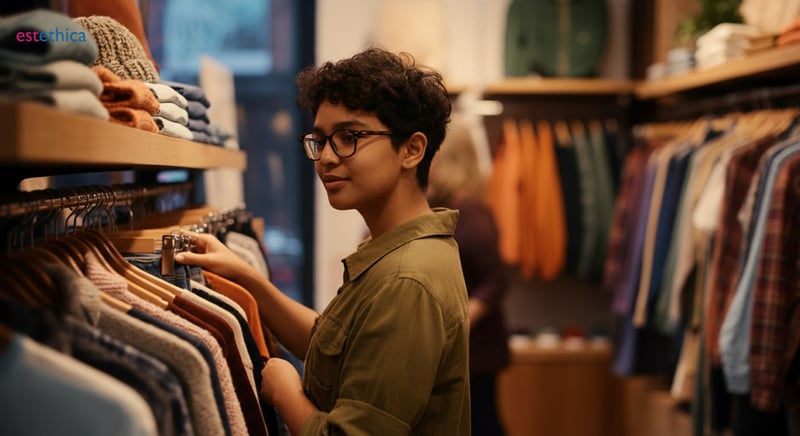Discovering the Allure of Sustainable Fashion
Explore the vibrant world of sustainable fashion with our in-depth guide on eco-friendly choices and ethical brands.
In recent years, sustainable fashion has rapidly transformed from a fleeting trend into a powerful movement. It emphasizes environmental responsibility and social consciousness, creating a positive impact both on the planet and within the communities involved in fashion production. As we delve into the world of sustainable fashion, we'll explore its defining characteristics today, provide a comprehensive guide for choosing eco-friendly clothing, highlight notable ethical fashion brands, and uncover affordable options for the conscious consumer.
What Defines Sustainable Fashion Today?
The Core Elements of Sustainable Fashion
Sustainable fashion is a multifaceted approach that integrates environmental and social responsibility into clothing production. This involves using eco-friendly clothing materials like organic cotton, hemp, and recycled polyester. These materials help reduce the environmental impact by minimizing water usage and chemical pollution. For instance, organic cotton uses 91% less water than conventional cotton.
- Eco-friendly clothing materials reduce environmental impact significantly.
- Fair labor practices ensure ethical treatment of workers.
- Innovative designs promote longevity and reduce waste.
Ethical fashion brands prioritize fair labor practices, ensuring workers receive fair wages and safe working conditions. Brands like Patagonia and Eileen Fisher are leading examples, emphasizing transparency and worker welfare. Additionally, innovative designs that focus on durability and timeless aesthetics contribute to reducing fashion waste.
Steps to Embrace Sustainable Fashion
- Research and choose brands committed to sustainability.
- Opt for quality over quantity to ensure longevity.
- Support local and ethical fashion brands to reduce carbon footprint.
Consumers can play a pivotal role by choosing sustainable apparel and supporting ethical fashion brands. By prioritizing quality over quantity, individuals can extend the life of their wardrobe, reducing the need for frequent replacements. Supporting local and ethical brands not only reduces the carbon footprint but also promotes a more equitable fashion industry.

Choosing Eco-Friendly Clothing: A Guide
Understanding the Impact of Eco-Friendly Materials
Eco-friendly clothing is crafted with the environment in mind, prioritizing materials and processes that are less harmful to the planet. When selecting these garments, look for natural fibers like organic cotton, wool, or hemp, which are grown without the use of pesticides and have a lower environmental impact. Certifications such as GOTS (Global Organic Textile Standard) and Fair Trade ensure that products meet specific ethical and environmental standards. Additionally, consider the lifecycle of your clothing, opting for items that offer durability and versatility to minimize waste.
- Organic cotton reduces water usage by 91% compared to conventional cotton.
- Hemp is a fast-growing crop that requires minimal pesticides.
- Wool is biodegradable and renewable, making it a sustainable choice.
These materials not only support sustainable fashion but also contribute to aesthetics training by promoting timeless designs that align with array aesthetics Belfast principles. By choosing eco-friendly clothing, you are participating in a conscious clothing movement that values both style and sustainability.
Evaluating the Lifecycle of Your Clothing
- Assess the durability and versatility of clothing items.
- Choose garments that can be easily repaired or upcycled.
- Consider the end-of-life options, such as recycling or composting.
Understanding the lifecycle of your clothing is crucial in reducing fashion waste. Opt for pieces that are not only stylish but also durable, ensuring they withstand the test of time. This approach aligns with the aesthetics quiz philosophy, encouraging consumers to make informed choices that reflect their values and commitment to sustainability.

Spotlight on Ethical Fashion Brands
The Role of Transparency in Ethical Fashion
Ethical fashion brands like Patagonia, Eileen Fisher, and People Tree prioritize transparency in their sourcing and production processes. This commitment ensures consumers are informed about the origins of their clothing, fostering trust and accountability. These brands emphasize fair trade practices, ensuring fair wages and safe working conditions for all employees. By doing so, they set a gold standard in sustainable fashion, contributing positively to society and the environment.
- Patagonia's transparency in sourcing promotes consumer trust.
- Eileen Fisher's commitment to fair wages enhances worker welfare.
- People Tree's focus on community development supports local economies.
These brands not only offer eco-friendly clothing but also align with aesthetics training principles, promoting designs that are both stylish and sustainable. Their efforts in transparency and ethical practices resonate with the array aesthetics Belfast philosophy, which values integrity and community impact.
How Ethical Fashion Brands Influence Consumer Choices
Ethical fashion brands influence consumer choices by demonstrating the benefits of conscious clothing. They highlight the importance of sustainable apparel, encouraging consumers to consider the environmental and social impact of their purchases. This shift towards green fashion is supported by aesthetics quizzes that educate consumers on making informed decisions.
- Educate consumers on the benefits of sustainable fashion.
- Promote the long-term value of eco-friendly clothing.
- Encourage support for brands with ethical practices.
By choosing ethical fashion brands, consumers contribute to a more sustainable future. This approach not only benefits the environment but also supports aesthetics training by promoting timeless and versatile designs that align with personal values and style preferences.

Exploring Affordable Conscious Clothing Options
Affordable Paths to Sustainable Fashion
Adopting sustainable fashion doesn't require a significant financial investment. Many mainstream and boutique retailers now offer affordable eco-friendly clothing lines. These collections often feature sustainable apparel made from recycled or organic materials, aligning with the aesthetics training principles of promoting environmentally conscious choices.
- Thrifting offers a cost-effective way to find unique, sustainable pieces.
- Clothing swaps provide an opportunity to refresh your wardrobe sustainably.
- Upcycling old garments extends their life and reduces waste.
These options not only support sustainable fashion but also resonate with the array aesthetics Belfast philosophy, which values creativity and resourcefulness in fashion. By embracing these practices, individuals can contribute to a more sustainable future without compromising on style or budget.
Steps to Create a Budget-Friendly Sustainable Wardrobe
- Identify local thrift stores and online platforms for second-hand shopping.
- Organize clothing swaps with friends or community groups.
- Learn basic mending techniques to repair and upcycle clothing.
These steps not only make sustainable fashion accessible but also align with the aesthetics quiz approach, encouraging individuals to explore their personal style while making environmentally conscious choices. By integrating these practices, you can build a wardrobe that reflects both your values and aesthetic preferences.
Innovative Eco-Friendly Fashion Materials
Accessible Sustainable Fashion for All
Frequently Asked Questions
What defines sustainable fashion today?
How can consumers choose eco-friendly clothing?
What role do ethical fashion brands play in the industry?
Are there affordable options for sustainable fashion?
How can consumers evaluate the lifecycle of their clothing?
Discover the Path to Your Healthiest Self with estethica's Award-Winning Services!
📞 Call Now for a Free Consultation!